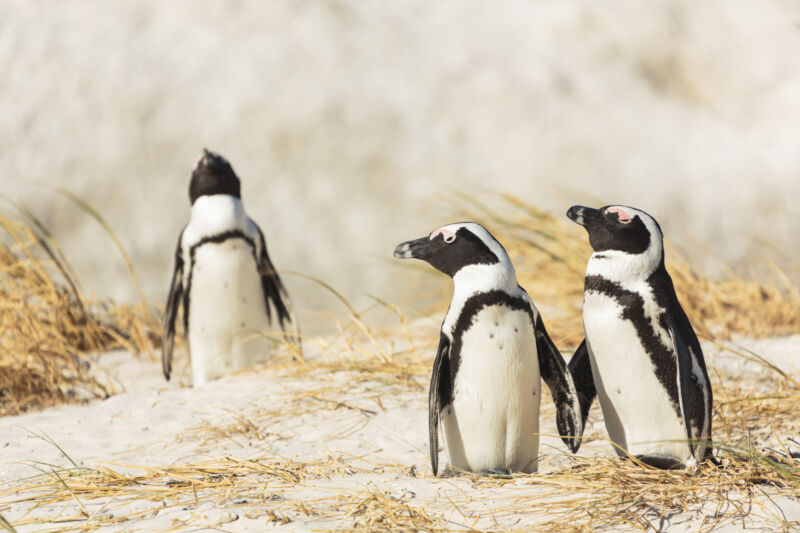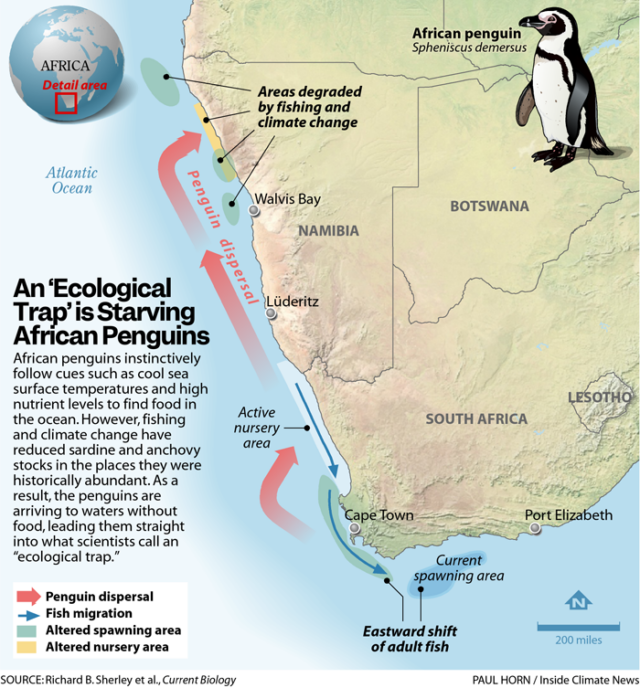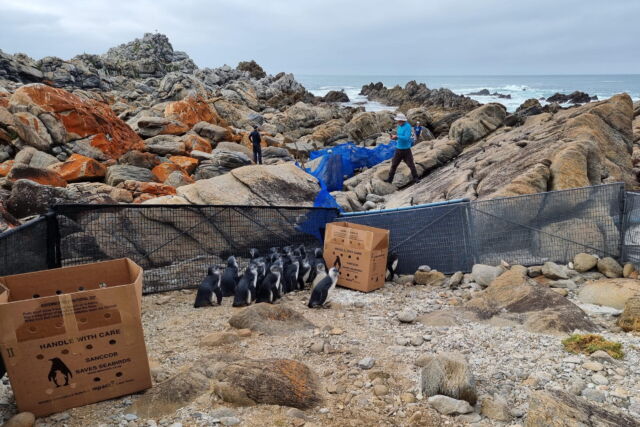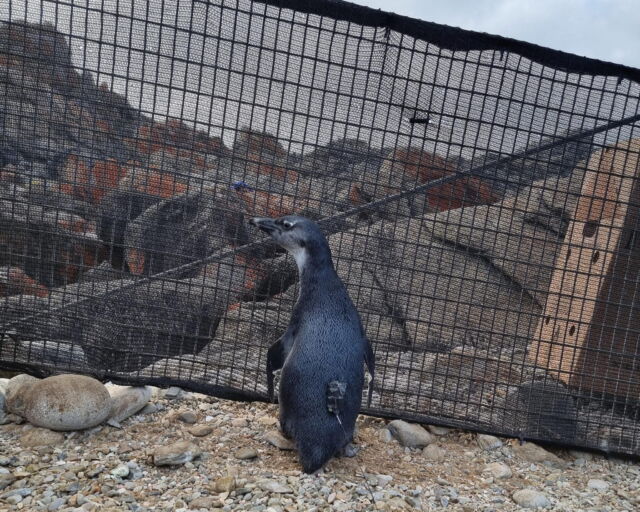A hatchery and protected sanctuary in South Africa is boosting penguin numbers.

African penguins on a beach near Simon's Town in South Africa.
spooh
CAPE TOWN, South Africa—A weathered, green building stands at the edge of the cozy suburban Table View neighborhood in Cape Town, just a few blocks down from a Burger King and a community library. Upon stepping inside, visitors’ feet squelch on a mat submerged in antibacterial liquid—one of the first signs this isn’t just another shop on the street.
A few steps further down the main hallway, a cacophony of discordant brays and honks fill the air. A couple more strides reveal the source of these guttarall calls: African penguins.
Welcome to the nonprofit Southern African Foundation for the Conservation Of Coastal Birds’ hatchery and nursery, where hundreds of these birds are hand-reared after being injured or abandoned in the wild.
While this conservation center is a flourishing refuge for African penguins, the species as a whole is in dire straits. Over the past century, African penguin populations have plummeted, dropping from around one million breeding pairs in the early 1900s to less than 10,000 in 2023 as environmental conditions have worsened due to increased fishing pressure and climate change, which have both decreased fish populations on which penguins rely.
The climate crisis has also fueled more frequent and severe weather events in South Africa such as floods and heat waves, resulting in an increased number of penguin parents abandoning their eggs to seek refuge.
The staff at the Foundation is working to hand-rear penguins with the goal to release most of them back into one of the threatened Cape colonies they came from. But some of these penguins are destined for a different destination: a rocky outcropping along the Eastern Cape of South Africa within the De Hoop Nature Reserve.
There, scientists and conservationists are working to establish a new penguin colony, which they hope will become a stronghold for the entire African penguin species.
The ecological trap
It’s difficult to pin a single threat to the demise of African penguins; oil spills, avian flu and extreme weather events have wreaked havoc on colonies across South Africa. These chronic issues combine with freak incidents: In 2021, a swarm of bees killed more than 60 African penguins on the popular Boulders Beach in Cape Town and, a year later, two huskies killed 19 penguins in the same area.
However, scientists say that one of the main causes of the seabirds’ decline is the intense fishing pressure on sardines and anchovies, the penguin’s main diet.
Fighting unemployment, low-income people fish around coastal beaches to support themselves, said Shanet Rutgers, an animal health technician at the Two Oceans Aquarium in South Africa, and there is a large commercial industry for purse-seine fishing, in which a wall of netting is cast around a school of fish.
“When they pull out too much fish in the ocean, they leave the colonies with almost little to nothing to feed on,” she said.
Over millions of years, African penguins have developed the ability to sense cues in the water that might indicate the availability of fish, such as low surface temperatures and high levels of chlorophyll. However, anchovies and sardines go through natural cycles of boom and bust, research shows, which can decrease fish availability for these seabirds. Compounding the problem, fishing and climate change have hammered fish populations in the areas off the coasts of Namibia and western South Africa that the penguins are programmed to visit to find food, putting them into what scientists are calling an “ecological trap,” according to a 2017 study.
“It’s like if you follow the supermarket sign and you drive there and the supermarket is closed down,” said Katta Ludynia, the lead researcher at the Foundation.

Inside Climate News
To help prevent further loss to penguin food supplies, the South African government announced in August that it would close off penguin foraging ranges around six of the country’s main breeding colonies to commercial and recreational fishing for 10 years beginning in January 2024. The government decided on these areas based on a few recommendations from a 2023 scientific report outlining the conservation status of African penguins. The report was co-authored by a panel of international penguin experts, economists and fisheries representatives, and was commissioned by the South African Department of Forestry, Fisheries and the Environment.
But environmental nonprofits, including the Foundation, say that the zones aren’t large enough to have a significant impact on protecting food supplies. Currently, the Foundation and other conservation organizations, including BirdLife South Africa and the World Wildlife Fund-South Africa, are in talks with fisheries groups to settle on a larger area, though Ludynia is doubtful they will reach an agreement.
“These areas are basically tiny, and not sufficient for the penguins,” Ludynia said.
An insurance policy
The De Hoop Nature Reserve, 146 miles east of Cape Town, is one of the largest federally protected wilderness areas in southern Africa, boasting sprawling coastlines, lush dunes and lots of fish.
In 2015, scientists at BirdLife South Africa and the Foundation identified a patch of rocks in this region as the perfect place to establish a new African penguin colony, to act as an “insurance policy” if the other colonies collapse, said Christina Hagen, a fellow at BirdLife South Africa who is leading the project. It was just missing one thing: penguins.
Back in the early 2000s, a group of penguins had tried to establish a colony in this area, but many of them were predated on by caracals, wild cats native to Africa. Though these predators still exist in De Hoop, those earlier forays showed that the area was already “penguin-approved,” said Hagen.
So, in 2018, conservationists got to work. To start, BirdLife South Africa scientists built a protective fence around the area to protect the black-and-white birds from the cats and avoid the same fate as the last colony. After that, it was a matter of luring the penguins in.
The groups decided to take cues from past seabird colony re-establishment projects by creating lifelike penguin decoys, similar to the wooden puffins created in Maine to attract these birds back to the New England coast in the U.S. Hagen took to social media to ask for ideas and a local artist, Roelf Daling, answered the call. He molded and painted 30 cement penguins that were scattered across De Hoop to trick wild penguins into thinking this area was already the hottest ticket in town.
“That was the idea, that the birds are at sea and they might spot a penguin sitting on a rock, then they might think, ‘oh, there’s a penguin, let me check this place out,” Ludynia said.
Now that it looked like penguins were at De Hoop, the scientists had to make sure it sounded like it, too. To do this, they installed two massive speakers—the kind you might see in a sports stadium—to play penguin calls on repeat.
“Standing right next to it, you kind of had to block your ears,” Hagen said.
African penguins hand-reared at the The Southern African Foundation for the Conservation of Coastal Birds were some of the first to be released at the De Hoop Nature Reserve in hopes of building a new colony. Credit: The Southern African Foundation for the Conservation of Coastal Birds

African penguins hand-reared at the The Southern African Foundation for the Conservation of
Coastal Birds were some of the first to be released at the De Hoop Nature Reserve in hopes of building a new colony.
The Southern African Foundation for the Conservation of Coastal Birds
Researchers had the decoys and speakers running for the next two years to try to naturally attract penguins. Then, in 2021, they released the first group of penguin fledgelings raised at the Foundation’s hatchery in Cape Town in the De Hoop reserve.
Unlike some other species of birds, such as crows and ducks, penguins do not often get attached to humans or lose survival instincts if they are raised in captivity for the beginning of their lives, making them prime candidates for release back into the wild, experts say. In fact, during the first release, the penguins dove straight into the water to swim to Namibia, similar to their wild counterparts.
“They were a little bit hesitant at first and sort of unsure of things,” Hagen said. “But as soon as they got in the water, it’s amazing that they kind of instinctively know what to do.”
Since 2021, more than 200 penguins have been released at the De Hoop Nature Reserve. In more recent releases, the Foundation and BirdLife teams have set up a temporary pen on the beach to keep the penguins overnight to give the birds more time to imprint on the site.
Most penguins are known to return to their birth colonies when it is time to breed, so the hope was that releasing the penguins in this area might mean that they would return when they reached sexual maturity in three to six years, Ludynia said. But until then, the researchers initially thought that all they were going to have to do was wait.
An early surprise
Then, in November 2022, Hagen was staring out at the rocks, watching a group of penguins loitering at the De Hoop site when she spotted a ball of fluff poking out of a crevice.
With the penguin calls from the speaker blasting in her ears, she crept closer to the fuzzy figure and realized that it was a chick, with another one standing beside it.
“We didn’t expect any penguins to come back until 2024,” Hagan said. “So when we saw the first ones in 2022 it was a very welcome surprise.”
She knew that the chicks’ parents were not from the Foundation birds because those birds from the center had not yet reached sexual maturity, but it was still a sign that the area was suitable for penguin breeding. This year, the researchers have seen four breeding pairs, yielding six chicks altogether.

A small transponder attached to the penguin helps researchers track the bird’s movements.
The Southern African Foundation for the Conservation of Coastal Birds
But that’s not the only sign that the project may be working, Ludynia said. Recently, the researchers installed a device in the De Hoop colony to monitor the penguins from the Foundation, each of which have a tiny tracking device implanted on their lower backs. And in August, their computers registered five dots crossing into the reserve, meaning that the penguins released from the nursery in Cape Town may be scoping out their potential new home, according to Ludynia.
“It’s quite promising that we’ve really seen quite a few of the birds that we released returned to De Hoop,” she said. “So that shows us that it seems to work, that they might think, ‘Oh, this is a good space.'”
This isn’t the only effort happening around the world to establish an artificial penguin colony: In Australia, a project is well underway to build back a population of little penguins in the small coastal town of Eden. Led by Nicholas Carlile, a senior researcher for the New South Wales government, scientists are working with the community to re-establish a little penguin colony that went extinct in 1993 and have used many of the same techniques that South African scientists have tapped into for the African penguins.
“South Africans are taking fantastic steps, both to protect their species and to try and tease apart what are the issues in their environment,” Carlile said. “Getting birds into new sites, even if they are mainland sites, it buys time. And that’s really what we’re trying to do. It gives hope.”
Though the De Hoop colony project has provided a bright spot for penguin conservationists, it hasn’t been without its setbacks. For example, in September, a massive storm tore through the nature reserve, destroying part of the predator fence and damaging the speakers and transponder reader that tracks birds from the Foundation. The fence was fixed within a week, but the team is still working to restore the transponder reader and speaker system. The more threatening risk, however, is the still-dwindling supply of anchovies and sardines in South African and Namibian waters, which could impact the new colony, as well, Ludynia said.
In 2024, the first group of penguins from the hatchery in Cape Town, which was released into the wild three years ago, will technically start reaching sexual maturity. This will be a telling year for whether the hatchery and nursery technique is actually working or not—a prospect that keeps Ludynia awake at night, she said. However, since the process takes so long and the penguins are declining so rapidly, the Foundation and BirdLife South Africa are already actively looking for the next site to establish a new colony.
“We don’t know what’s going to happen, but we are literally so desperate that, you know, anything that works well, we’ll go for it,” she said.
Kiley Price is a New York-based science journalist who focuses on biodiversity, fisheries, ocean health and climate change. She is currently a master’s candidate at New York University’s Science, Health and Environmental Reporting Program. Previously, Kiley earned her bachelor’s degree in biology with a minor in journalism at Wake Forest University, where she spent a month in Thailand reporting on the intersection of Buddhism and the Thai environmental movement as a Pulitzer Fellow. Her work has appeared in National Geographic, Mongabay, Yale Environment 360 and more.
This story originally appeared on Inside Climate News.
Source




3175x175(CURRENT).thumb.jpg.b05acc060982b36f5891ba728e6d953c.jpg)




Recommended Comments
There are no comments to display.
Join the conversation
You can post now and register later. If you have an account, sign in now to post with your account.
Note: Your post will require moderator approval before it will be visible.